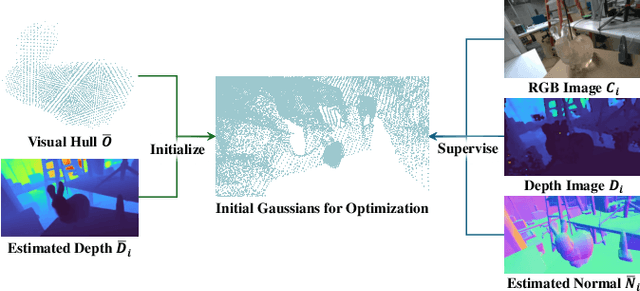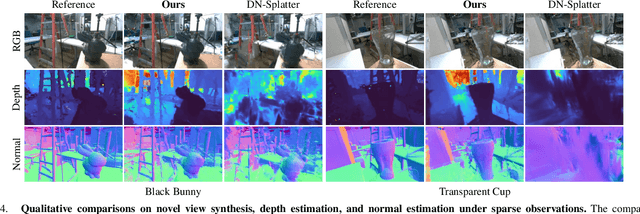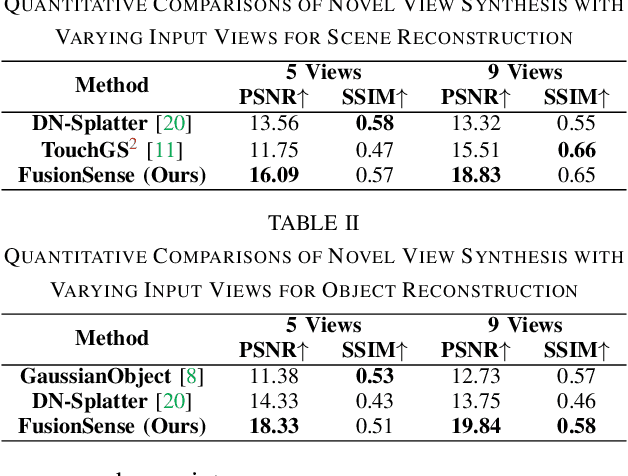Wenzhen Yuan
VLRMBench: A Comprehensive and Challenging Benchmark for Vision-Language Reward Models
Mar 10, 2025Abstract:Although large visual-language models (LVLMs) have demonstrated strong performance in multimodal tasks, errors may occasionally arise due to biases during the reasoning process. Recently, reward models (RMs) have become increasingly pivotal in the reasoning process. Specifically, process RMs evaluate each reasoning step, outcome RMs focus on the assessment of reasoning results, and critique RMs perform error analysis on the entire reasoning process, followed by corrections. However, existing benchmarks for vision-language RMs (VLRMs) typically assess only a single aspect of their capabilities (e.g., distinguishing between two answers), thus limiting the all-round evaluation and restricting the development of RMs in the visual-language domain. To address this gap, we propose a comprehensive and challenging benchmark, dubbed as VLRMBench, encompassing 12,634 questions. VLRMBench is constructed based on three distinct types of datasets, covering mathematical reasoning, hallucination understanding, and multi-image understanding. We design 12 tasks across three major categories, focusing on evaluating VLRMs in the aspects of process understanding, outcome judgment, and critique generation. Extensive experiments are conducted on 21 open-source models and 5 advanced closed-source models, highlighting the challenges posed by VLRMBench. For instance, in the `Forecasting Future', a binary classification task, the advanced GPT-4o achieves only a 76.0% accuracy. Additionally, we perform comprehensive analytical studies, offering valuable insights for the future development of VLRMs. We anticipate that VLRMBench will serve as a pivotal benchmark in advancing VLRMs. Code and datasets will be available at https://github.com/JCruan519/VLRMBench.
Social Gesture Recognition in spHRI: Leveraging Fabric-Based Tactile Sensing on Humanoid Robots
Mar 05, 2025Abstract:Humans are able to convey different messages using only touch. Equipping robots with the ability to understand social touch adds another modality in which humans and robots can communicate. In this paper, we present a social gesture recognition system using a fabric-based, large-scale tactile sensor integrated onto the arms of a humanoid robot. We built a social gesture dataset using multiple participants and extracted temporal features for classification. By collecting real-world data on a humanoid robot, our system provides valuable insights into human-robot social touch, further advancing the development of spHRI systems for more natural and effective communication.
Sensor-Invariant Tactile Representation
Feb 27, 2025Abstract:High-resolution tactile sensors have become critical for embodied perception and robotic manipulation. However, a key challenge in the field is the lack of transferability between sensors due to design and manufacturing variations, which result in significant differences in tactile signals. This limitation hinders the ability to transfer models or knowledge learned from one sensor to another. To address this, we introduce a novel method for extracting Sensor-Invariant Tactile Representations (SITR), enabling zero-shot transfer across optical tactile sensors. Our approach utilizes a transformer-based architecture trained on a diverse dataset of simulated sensor designs, allowing it to generalize to new sensors in the real world with minimal calibration. Experimental results demonstrate the method's effectiveness across various tactile sensing applications, facilitating data and model transferability for future advancements in the field.
Learning to Double Guess: An Active Perception Approach for Estimating the Center of Mass of Arbitrary Objects
Feb 04, 2025Abstract:Manipulating arbitrary objects in unstructured environments is a significant challenge in robotics, primarily due to difficulties in determining an object's center of mass. This paper introduces U-GRAPH: Uncertainty-Guided Rotational Active Perception with Haptics, a novel framework to enhance the center of mass estimation using active perception. Traditional methods often rely on single interaction and are limited by the inherent inaccuracies of Force-Torque (F/T) sensors. Our approach circumvents these limitations by integrating a Bayesian Neural Network (BNN) to quantify uncertainty and guide the robotic system through multiple, information-rich interactions via grid search and a neural network that scores each action. We demonstrate the remarkable generalizability and transferability of our method with training on a small dataset with limited variation yet still perform well on unseen complex real-world objects.
GelBelt: A Vision-based Tactile Sensor for Continuous Sensing of Large Surfaces
Jan 09, 2025Abstract:Scanning large-scale surfaces is widely demanded in surface reconstruction applications and detecting defects in industries' quality control and maintenance stages. Traditional vision-based tactile sensors have shown promising performance in high-resolution shape reconstruction while suffering limitations such as small sensing areas or susceptibility to damage when slid across surfaces, making them unsuitable for continuous sensing on large surfaces. To address these shortcomings, we introduce a novel vision-based tactile sensor designed for continuous surface sensing applications. Our design uses an elastomeric belt and two wheels to continuously scan the target surface. The proposed sensor showed promising results in both shape reconstruction and surface fusion, indicating its applicability. The dot product of the estimated and reference surface normal map is reported over the sensing area and for different scanning speeds. Results indicate that the proposed sensor can rapidly scan large-scale surfaces with high accuracy at speeds up to 45 mm/s.
NormalFlow: Fast, Robust, and Accurate Contact-based Object 6DoF Pose Tracking with Vision-based Tactile Sensors
Dec 12, 2024Abstract:Tactile sensing is crucial for robots aiming to achieve human-level dexterity. Among tactile-dependent skills, tactile-based object tracking serves as the cornerstone for many tasks, including manipulation, in-hand manipulation, and 3D reconstruction. In this work, we introduce NormalFlow, a fast, robust, and real-time tactile-based 6DoF tracking algorithm. Leveraging the precise surface normal estimation of vision-based tactile sensors, NormalFlow determines object movements by minimizing discrepancies between the tactile-derived surface normals. Our results show that NormalFlow consistently outperforms competitive baselines and can track low-texture objects like table surfaces. For long-horizon tracking, we demonstrate when rolling the sensor around a bead for 360 degrees, NormalFlow maintains a rotational tracking error of 2.5 degrees. Additionally, we present state-of-the-art tactile-based 3D reconstruction results, showcasing the high accuracy of NormalFlow. We believe NormalFlow unlocks new possibilities for high-precision perception and manipulation tasks that involve interacting with objects using hands. The video demo, code, and dataset are available on our website: https://joehjhuang.github.io/normalflow.
* 8 pages, published in 2024 RA-L, website link: https://joehjhuang.github.io/normalflow
Tactile DreamFusion: Exploiting Tactile Sensing for 3D Generation
Dec 09, 2024Abstract:3D generation methods have shown visually compelling results powered by diffusion image priors. However, they often fail to produce realistic geometric details, resulting in overly smooth surfaces or geometric details inaccurately baked in albedo maps. To address this, we introduce a new method that incorporates touch as an additional modality to improve the geometric details of generated 3D assets. We design a lightweight 3D texture field to synthesize visual and tactile textures, guided by 2D diffusion model priors on both visual and tactile domains. We condition the visual texture generation on high-resolution tactile normals and guide the patch-based tactile texture refinement with a customized TextureDreambooth. We further present a multi-part generation pipeline that enables us to synthesize different textures across various regions. To our knowledge, we are the first to leverage high-resolution tactile sensing to enhance geometric details for 3D generation tasks. We evaluate our method in both text-to-3D and image-to-3D settings. Our experiments demonstrate that our method provides customized and realistic fine geometric textures while maintaining accurate alignment between two modalities of vision and touch.
FusionSense: Bridging Common Sense, Vision, and Touch for Robust Sparse-View Reconstruction
Oct 10, 2024



Abstract:Humans effortlessly integrate common-sense knowledge with sensory input from vision and touch to understand their surroundings. Emulating this capability, we introduce FusionSense, a novel 3D reconstruction framework that enables robots to fuse priors from foundation models with highly sparse observations from vision and tactile sensors. FusionSense addresses three key challenges: (i) How can robots efficiently acquire robust global shape information about the surrounding scene and objects? (ii) How can robots strategically select touch points on the object using geometric and common-sense priors? (iii) How can partial observations such as tactile signals improve the overall representation of the object? Our framework employs 3D Gaussian Splatting as a core representation and incorporates a hierarchical optimization strategy involving global structure construction, object visual hull pruning and local geometric constraints. This advancement results in fast and robust perception in environments with traditionally challenging objects that are transparent, reflective, or dark, enabling more downstream manipulation or navigation tasks. Experiments on real-world data suggest that our framework outperforms previously state-of-the-art sparse-view methods. All code and data are open-sourced on the project website.
MM-CamObj: A Comprehensive Multimodal Dataset for Camouflaged Object Scenarios
Sep 24, 2024



Abstract:Large visual-language models (LVLMs) have achieved great success in multiple applications. However, they still encounter challenges in complex scenes, especially those involving camouflaged objects. This is primarily due to the lack of samples related to camouflaged scenes in the training dataset. To mitigate this issue, we construct the MM-CamObj dataset for the first time, comprising two subsets: CamObj-Align and CamObj-Instruct. Specifically, CamObj-Align contains 11,363 image-text pairs, and it is designed for VL alignment and injecting rich knowledge of camouflaged scenes into LVLMs. CamObj-Instruct is collected for fine-tuning the LVLMs with improved instruction-following capabilities, and it includes 11,363 images and 68,849 conversations with diverse instructions. Based on the MM-CamObj dataset, we propose the CamObj-Llava, an LVLM specifically designed for addressing tasks in camouflaged scenes. To facilitate our model's effective acquisition of knowledge about camouflaged objects and scenes, we introduce a curriculum learning strategy with six distinct modes. Additionally, we construct the CamObj-Bench to evaluate the existing LVLMs' capabilities of understanding, recognition, localization and count in camouflage scenes. This benchmark includes 600 images and 7 tasks, with a total of 9,449 questions. Extensive experiments are conducted on the CamObj-Bench with CamObj-Llava, 8 existing open-source and 3 closed-source LVLMs. Surprisingly, the results indicate that our model achieves a 25.84% improvement in 4 out of 7 tasks compared to GPT-4o. Code and datasets will be available at https://github.com/JCruan519/MM-CamObj.
An Intelligent Robotic System for Perceptive Pancake Batter Stirring and Precise Pouring
Jul 01, 2024Abstract:Cooking robots have long been desired by the commercial market, while the technical challenge is still significant. A major difficulty comes from the demand of perceiving and handling liquid with different properties. This paper presents a robot system that mixes batter and makes pancakes out of it, where understanding and handling the viscous liquid is an essential component. The system integrates Haptic Sensing and control algorithms to autonomously stir flour and water to achieve the desired batter uniformity, estimate the batter's properties such as the water-flour ratio and liquid level, as well as perform precise manipulations to pour the batter into any specified shape. Experimental results show the system's capability to always produce batter of desired uniformity, estimate water-flour ratio and liquid level precisely, and accurately pour it into complex shapes. This research showcases the potential for robots to assist in kitchens and step towards commercial culinary automation.
 Add to Chrome
Add to Chrome Add to Firefox
Add to Firefox Add to Edge
Add to Edge